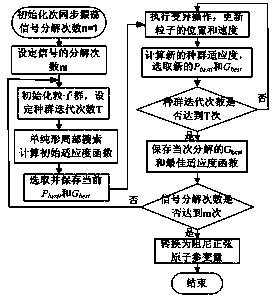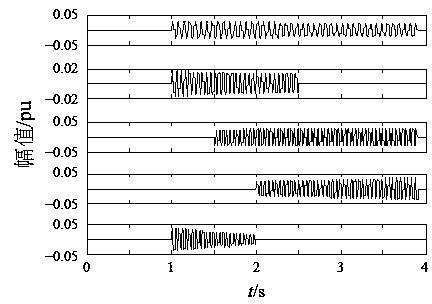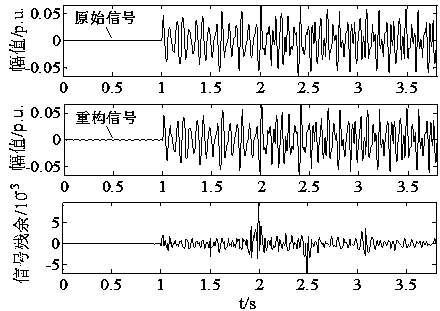Power system sub-synchronous oscillation mode identification method
A subsynchronous oscillation and mode identification technology, applied in the direction of reducing/preventing power oscillation, etc., can solve the problem of difficult to effectively identify subsynchronous oscillation modes of power systems, difficult to distinguish similar frequency components by wavelet analysis, and difficult to extract torsional vibration modes Problems such as dynamic damping parameters can be solved to achieve the effect of enhancing global detection ability, improving local development ability, and improving simplicity and flexibility
- Summary
- Abstract
- Description
- Claims
- Application Information
AI Technical Summary
Problems solved by technology
Method used
Image
Examples
specific Embodiment approach
[0095] The following will combine figure 1 The specific embodiment of the present invention is described in detail, including steps:
[0096] Step 1: Construct the atomic library of the subsynchronous oscillation signal to be identified with the modal parameters of the subsynchronous oscillation signal as the atomic index, and initialize the particle swarm based on the atomic library of the subsynchronous oscillation signal; the atomic library of the subsynchronous oscillation signal is a damped sine Quantitative atom model, the atomic index in this model γ=(F, φ, ρ, t s ,t e ), where F is the atomic frequency, φ is the phase, ρ is the atomic damping coefficient, t s with t e are the start and end moments of the damped sinusoidal atoms, respectively.
[0097] Step 2, set the total number of signal decomposition m=20, and initialize the subsynchronous oscillation signal decomposition number n=1; set the total number of particle swarm decomposition iterations T=60 according ...
Embodiment 1
[0117] In this embodiment, the method of the present invention is specifically described by taking the oscillation test signal with time-varying frequency as an example, including steps:
[0118] Step 1. Construct an oscillation test signal with time-varying frequency. The test signal is composed of five modes. The expression of the signal s(t) is as follows:
[0119] s ( t ) = 6 e - 0.08 t sin ( 30 πt ) , 1 ≤ t ≤ 3.9 s ...
Embodiment 2
[0141] This embodiment takes Image 6 The method of the present invention is specifically described by taking the IEEE first standard model as an example.
[0142] See Image 6 In the IEEE first standard model, the generator shaft system adopts a six-mass spring model, and the series compensation degree is 66.21%. There are five torsional vibration modes in this model, and the torsional vibration frequencies are 15.71Hz, 20.21Hz, 25.55Hz, 32.28Hz and 47.45Hz.
[0143] In order to extract the subsynchronous oscillation mode related to the torsional vibration strength of the mass, this embodiment selects the generator speed deviation Δω as the analysis signal. At the moment of 1.5s, the system has a three-phase short circuit at node B through the transition impedance, and the fault duration is 0.075s. The Δω waveform of the period from 0 to 12s is recorded, and the sampling frequency is 1kHz.
[0144] The Δω waveform of the disturbance is a nonlinear and non-stationary oscillat...
PUM
 Login to View More
Login to View More Abstract
Description
Claims
Application Information
 Login to View More
Login to View More - R&D
- Intellectual Property
- Life Sciences
- Materials
- Tech Scout
- Unparalleled Data Quality
- Higher Quality Content
- 60% Fewer Hallucinations
Browse by: Latest US Patents, China's latest patents, Technical Efficacy Thesaurus, Application Domain, Technology Topic, Popular Technical Reports.
© 2025 PatSnap. All rights reserved.Legal|Privacy policy|Modern Slavery Act Transparency Statement|Sitemap|About US| Contact US: help@patsnap.com



